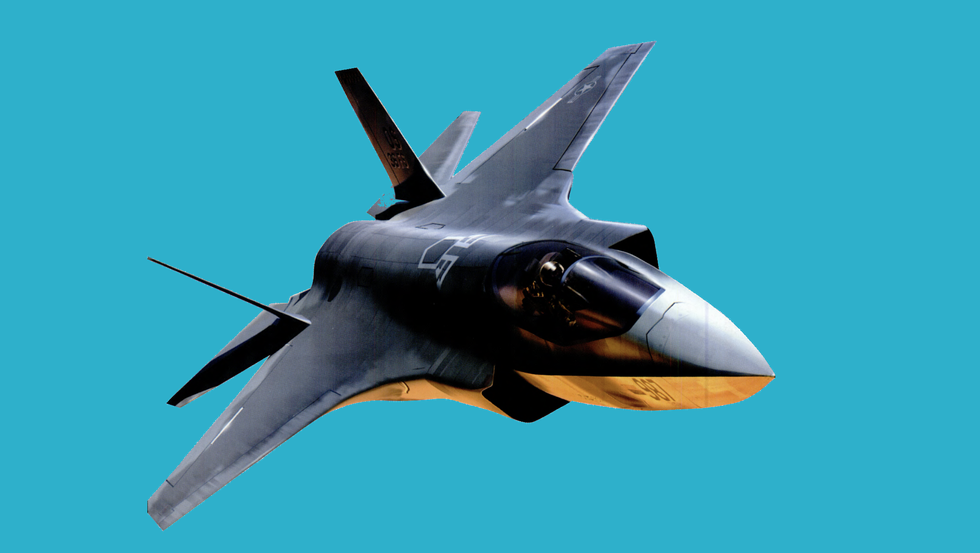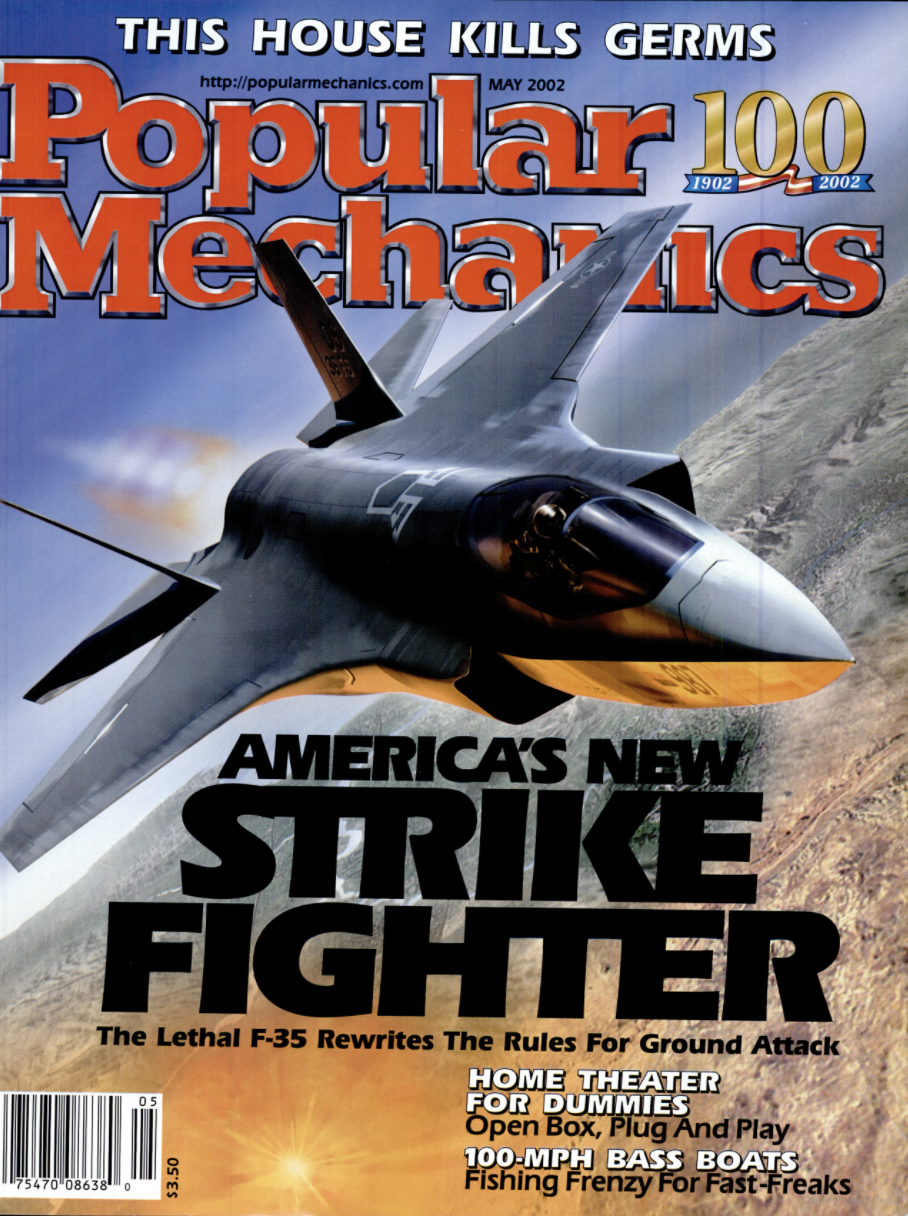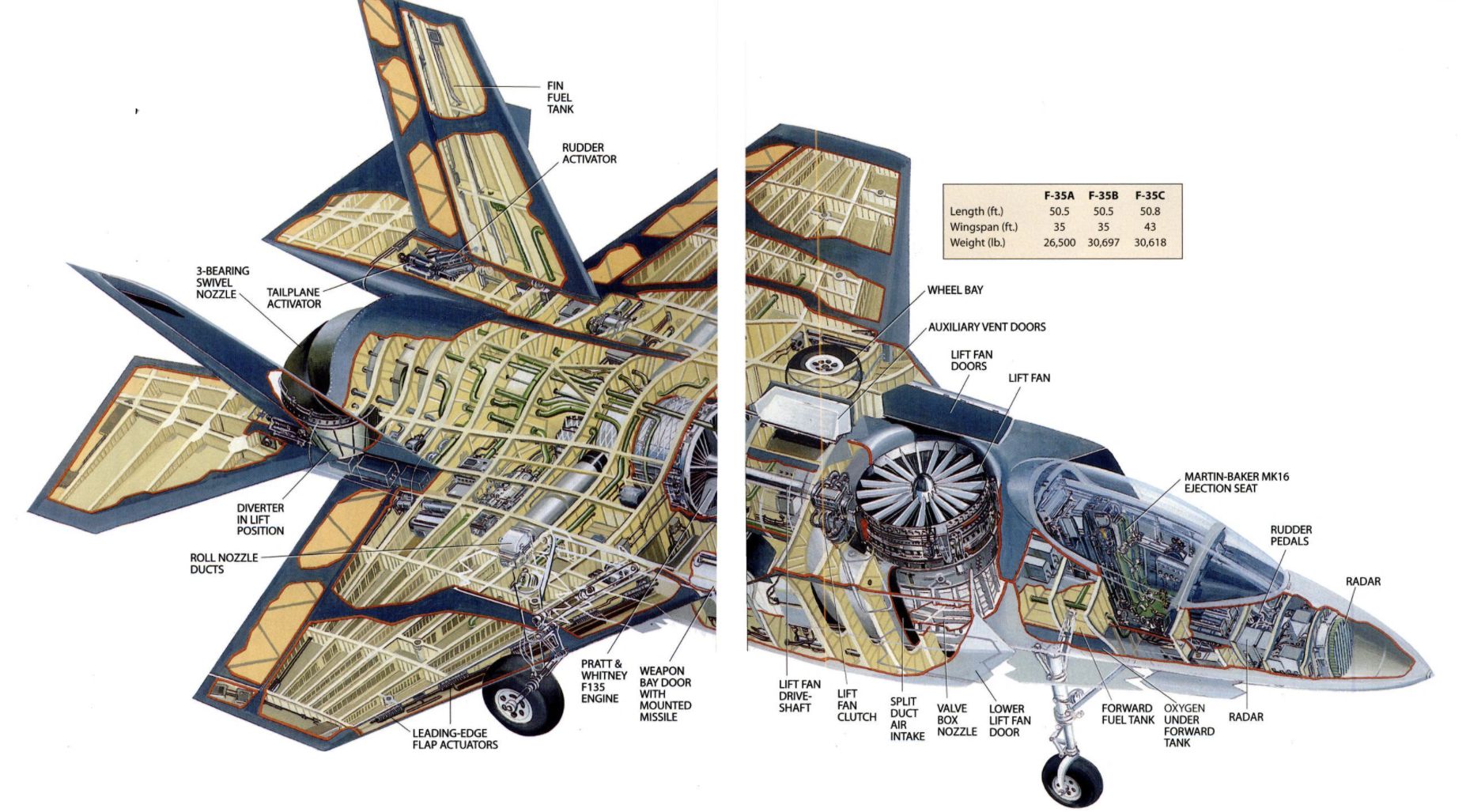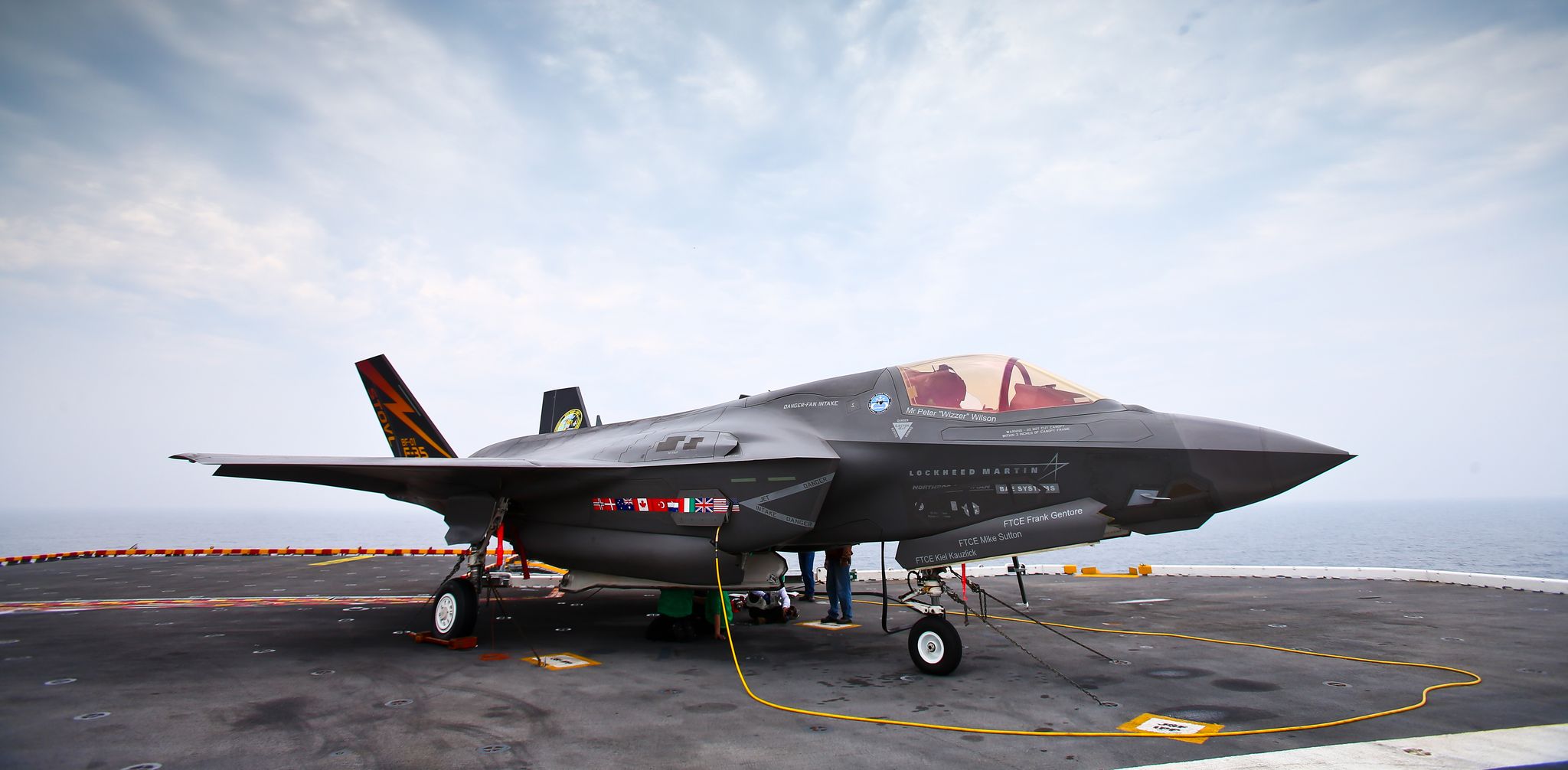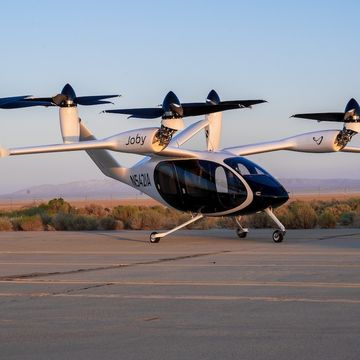In the May 2002 issue, Popular Mechanics explored the U.S. Military's newest fighter: the F-35. Diving deep into the plane's three variants—the F-35A, B, and C—the article reported on the project in its infancy and its ambitious plans to start replacing the F-22 and A-10 by 2010. Famously, the F-35 became plagued with delays and cost overruns, but despite these setbacks, the Joint Strike Fighter remains the most advanced jet fighter in the world—at least until the rumored Next-Generation Air Dominance program comes for the crown.
The planes that won the Cold War are getting old. They pack as lethal a punch as ever, but like the baby boomer generation they protected, they are beginning to show their age.
The electrical system of the Air Force's A-10 Thunderbolt, better known as the Warthog because of its ungainly tail-engine configuration, lacks the juice to handle modern radar and battle-management computers. Salty sea air has hastened the breakdown of the insulation in some Navy jets, causing scores of fires and prompting a program to install arc-fault circuit breakers. The Marines are seriously worried that they could run out of Harrier jump jets.
There is no argument within the defense community that America needs a new family of military aircraft. The problem is money. Keeping one step ahead of the former Soviet Union has driven the cost of aircraft to astounding heights. The U.S. Air Force says that the "fly-away" cost of the first 10 F-22 Raptors, the last fighters designed to counter the Soviet threat, is $99.7 million each.
When the U.S.S.R. folded its tent, the Pentagon decided it was time not only for new planes, but also for a less costly way of doing business. Thus, the birth of America's newest combat aircraft, the F-35 Joint Strike Fighter (JSF).
The F-35s are a family of three aircraft, designated the F-35A, F-35B and F-35C. Similar in shape and size, and powered by the same basic engine, the F-35s will share between 70 and 90 percent of their parts. Yet, under the skin they are three distinctly different machines.
The U.S. Air Force will fly the F-35A. Designed to take off and land from conventional runways, it bears a close family resemblance to the F-22 Raptor air superiority fighter-a trait shared by all three JSF variants. The Air Force wants to use the F-35A to replace its obsolete fleet of A-10 tank killers and rapidly aging F-16 fighters.
“The [F-35A] would allow for migration by U.S.forces to an almost all-stealth fighter force by 2025," says Edward Aldridge, undersecretary of Defense for Acquisitions.
In a future war, F-22s and F-35As would fly complementary missions. The F-22 would establish and maintain air superiority, while the F-35As would attack the enemy on the ground. Planners envision that during the first hours of a war F-35As would take advantage of their near Mach 2 speed and stealth to deliver a pair of internally carried 2000-pound "supersmart" bombs against command and control targets.
Once the enemy was blinded and stealth became unnecessary, ground crews could fit the two hardpoints on the F-35As wings with a variety of missiles and bombs. If the Air Force holds to its current plans, it will buy 1763 F-35As. The least complicated of the designs, they will cost more than $30 million each.
U.S. Marines will fly the F-35B, which is detailed in the cutaway drawing above. While its overall shape, size and radar-absorbing stealth coatings are identical to the Air Force F-35A, the powerplant and airframe have been modified for short takeoff and vertical landing (STOVL) operation. The Marines will use the F-35B to retire their current—and rapidly dwindling—fleet of British-designed AV-8B Harrier jump jets. F-35Bs would be deployed with Marine Expeditionary Units and operate off short-runway landing ships. Eventually, the Marines hope to buy 609 F-35Bs to replace the Harriers, as well as their carrier-based F/A-18C/D Hornets.
The Navy will fly the most visibly different member of the JSF family, the F-35C. Built using the same airframe and engine as the Air Force and Marine variants, it will have larger wing and tail-control surfaces. These are needed to maintain control at the lower speeds required for carrier approaches. The wingbox and airframe will be strengthened to absorb the shock of catapult launches and arrested landings.
Additional wing area—which is created with larger leading-edge flaps and foldable wingtip sections—means the F-35C will be able to carry more fuel for a longer operating range and a larger payload. The Navy hopes to buy 480 of the aircraft to replace its aging fleet of Hornets. In a future war, the F-35Cs would work in concert with the F/A-18E/F Super Hornets.
The First Dogfight
The F-35 is the product of an aggressive aircraft design competition that pitted the nation's two top military aircraft manufacturers, Lockheed Martin and Boeing, in a corporate dogfight. Each company was required to build and fly its version of the JSF, designated the Boeing X-32 and Lockheed Martin X-35. But that was only the start.
With the JSF project the Pentagon not only wanted a superior aircraft, it also wanted to pull in the reins on escalating costs. To put this strategy into action, manufacturers were instructed to design planes with as many common parts as possible. Beyond designing and building an aircraft, each company also was required to demonstrate that its design would be the most economical for the armed forces to operate.
In the end, the task of selecting a contractor for the “winner take all" contract proved so complex that some 250 Defense Department officials were involved in evaluating the data.
"Both of the proposals were very good. Both demo programs were very good," says James Roche, secretary of the Air Force. "It became clear, as we went through this process, that the Lockheed Martin team was a clear winner from the point of view of best value for the government. I would not characterize (the decision] as a squeaker at all, nor would I say by a mile."
Old and Bold
Lockheed Martin's design represents a blend of old and bold technologies. The F-35 achieves its stealthy, small radar cross by relying heavily on an airframe and engine inlet design that borrows liberally from the F-22 Raptor, also built by Lockheed Martin.
Initially, F-35s will use a modified version of the Pratt & Whitney F119 engine that powers the F-22. The F-35's engine is designated the F135. If the F-35 goes into full production, all three versions of the aircraft also could use a direct-replacement F120 engine, to be built by General Electric.
The F-35 makes its most radical departure from the past with the choice of the lifting system for the F-35B jump jet. The Harriers currently operated by the Marines achieve vertical flight by diverting downward the hot gases expelled by the engine. The F-35B uses a design built around a lift fan. Lifting with cooler air offers several advantages. Chief among them are less heat stress on the engine and a smaller infrared signature for anti-aircraft missiles to home in on. The tradeoff is a higher degree of mechanical sophistication.
There are three parts to the lifting system. The first part is the lift fan. About half of the thrust needed to hover and land is created by forcing ambient air downward through a pair of doors that open directly behind the cockpit. Power comes from a 2-stage low-pressure turbine on the engine and is coupled to the lift fan through a clutch.
The fan itself consists of a pair of counterrotating turbines that are capable of creating as much as 18,000 pounds of thrust. Roughly the same amount of thrust is created by blasting hot gases from the engine downward, through a 3-bearing nozzle, the system's second part. Finally, a pair of roll nozzles located under the wings provide balance.
Moving To the Flight Line
Thus far, the Defense Department has committed $22.9 billion for the construction of 22 F-35s. The Air Force and Marines will each get five flying aircraft, the Navy four. The remaining eight will be nonflying versions for various testing programs. The Pentagon estimates it will eventually need as many as 3,000 F-35s, at a total cost of $200 billion.
The British government, which has been involved with the JSF project since the inception of the program in the mid-1990s, has expressed interest in buying either the F-35B or F-35C. A final decision is not likely until 2010 when, among other things, the prices of these aircraft can be estimated with greater certainty.
Barring a wholesale shift to unmanned vehicles or unanticipated engineering problems—both viewed as unlikely events—the F-35A will begin replacing the Air Force F-16s and A-10s by 2010. The following year, the Marines and the Navy will take delivery of their first F-35Bs and F-35Cs.

